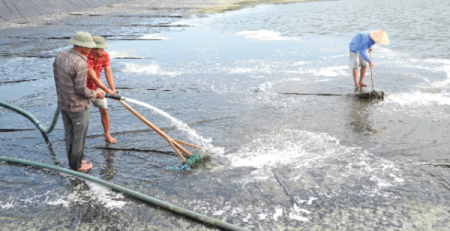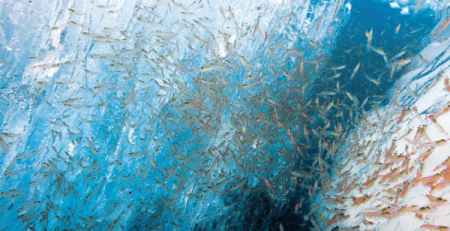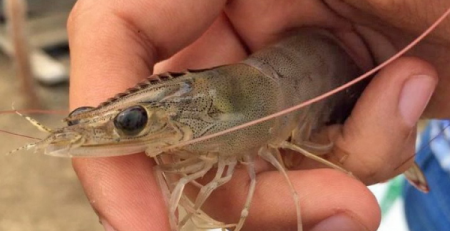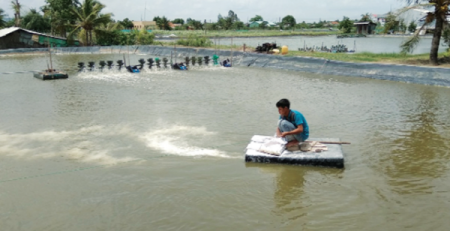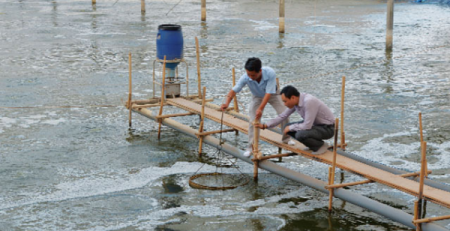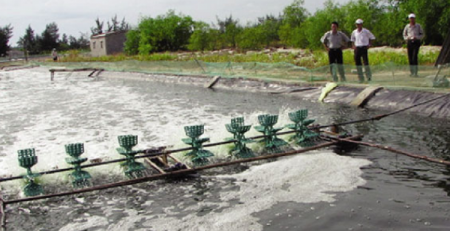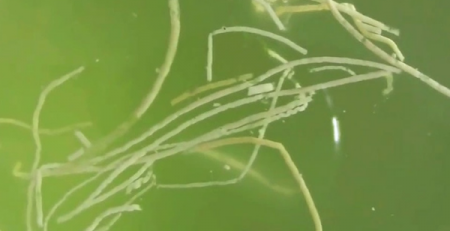Pond treatment lost water color
The loss of water color in ponds or algae loss in the first breeding month will adversely affect the health of shrimp. Therefore, it is necessary to determine the causes and appropriate measures to minimize harm to shrimp.

Regular application of microorganism helps stabilize water quality
Characteristics
When the algae develops steadily, the pond water will be light green or yellowish brown. These are two colors suitable for shrimp. Light green juice (young banana shoots): Due to the development of green algae (Chlorophyta), these algae often thrive in fresh or brackish water (less than 10 ‰). This is also the most suitable water color for shrimp, green algae in addition to playing an important role in the food chain, also have the effect of stabilizing the aquatic elements, chemical and physical in the pond, absorption of organic substances through This reduces the amount of toxic gas in the pond. Yellowish brown water: due to the development of silage (Bacillariophyta), this algae usually grows in brackish water at the beginning of the season.
Reason
There are many different causes of water loss in shrimp ponds, such as: farmers use some chemicals to kill algae; Ponds lack nutrient salt (N, P, K …); Causes water color to dark at night, bad weather; The oxygen content in the pond at night is not guaranteed, the day is short of CO2; Change water density algae …
How to fix
Low algae pangasius occurs when the nutrient solution, nutrient depletion ponds, organic matter suspended in ponds … Many synthetic solutions are used to aid sedimentation and nutritional supplements to water the ponds.
In the case of loss of color during the first culture month, as the algae are deficient in feed, this is very common in newly built ponds, ponds on sandy substrates, ponds with bottom canvas or alum ponds. . If the ponds in this case need nutrient supplement and nutrient solution for algae at higher doses, depending on nutritional conditions of each region and each pond.
Algae dies mostly due to farmers using less safe chemicals (Formol, Chlorine, BKC, …) will cause algae very difficult. When the water is discolored in the first month, the shrimp will reduce the prey, shrimp pulling or running algae, algae at the bottom of the pond, resulting in large loss, so the farmer should consider when choosing. The treatment of ponds as well as the correct use of doses to avoid the development of algae in ponds.
Comprehensive prevention measures
In order to avoid the above phenomenon, the water coloring is done in the right way at the beginning of the crop, before stocking, when the water is discolored and actively coloring in the pre-filled ponds to supply ponds when necessary. .
Water color should be checked and adjusted such as pH (7.5 – 8.5), alkalinity (80-150 ppm), NH3 (<0.1mg / l), H2S (<0, 03 mg / l).
Once the water is taken into the pond, it is necessary to disinfect the water with chlorine to destroy the pathogen for the shrimp and then cause coloring by applying fertilizer, rice bran, soybean meal, molasses, using mixed minerals, or preferably Use of probiotics specifically for water coloring in shrimp ponds.
Periodically, 5-7 days supplement of bacteria in the pond to promote beneficial bacteria develop, decompose organic waste in the pond, absorb and prevent the formation of toxic gas in the pond, increase Resistance and intestinal stimulation are strong, well digested.
For white shrimp ponds in the form of Biofloc combined with the density of shrimps over 350 / m2, there should be air blowers to ensure oxygen dissolved in enough water and bacteria often to create enzymes. Good life for shrimp.
In the case of difficult to color due to heavy chemical use, the bottom of the pond is more sandy, high salinity should use the product coloring and minerals to cause water color pond.
Management of strict feeding avoids overfeeding to limit environmental pollution, affecting water quality.
Source: contom.vn


